This post was updated on April 2, 2020, to reflect the latest information and the addition of the GoFundMe option.
Donate now. Give today. Make a gift. No matter how you phrase it, fundraising means making clear and compelling asks. But your website isn’t the only place where you can ask your supporters to give. We’ll show you how to get donations and raise money online using donate buttons in four additional places, from YouTube to Google, plus a new donate button option from GoFundMe.
Offsite Fundraising Considerations
Who doesn’t love a quick fundraising win? Expanding the number of ways you collect donations comes with a lot of perks, especially when you can set it and forget it.
Enabling donate buttons on places other than your website can be a great way to capture people in places where they already engage or feel an emotional reaction to your content. For example, wouldn’t it be nice if someone watched a video on social media and clicked to donate in the moment? They wouldn’t have to leave the page to make a gift, which could cause you to lose people along the way.
That said, there are some downsides to setting up “donate now” buttons on websites that aren’t under your control:
- The donation experience might not match your brand or style.
- Donations could be processed using a system that’s different than what you use normally.
- Funds might not be distributed as quickly or as regularly as you’d like.
- Fundraisers might not receive the donor data needed for effective follow-up.
Are any of these deal breakers for your organization? When you’re brainstorming how to get donations from more people, be sure to weigh the pros and cons of where they give. You should be especially cautious if the donation experience on your organization’s own website still needs improving – or doesn’t exist at all.
(If you’re just getting started with online donations, we’ve previously written about the benefits of offering donations on your site and why we recommend payment processing using Stripe.)
Building relationships with donors is an important aspect of fundraising for the long term, and it can get extra tricky when you start collecting online donations elsewhere. Make sure the donation process on your website is the highest priority since it’s where you have the most control over the donation experience from start to finish.
Types of Donate Buttons
If you’re looking to boost the number of donors giving to your nonprofit, there are four places where you can set up donation buttons in addition to your website. We’ll break down each option by who you might reach, how to get it, processing, payout, the donor data you receive, and what it looks like in the real world.
Facebook Donate Button
The Facebook donate button is more than just a passive call-to-action on your nonprofit’s page. Did you know that you can add a donate button to your Facebook posts and live videos?
- Who You Can Reach: The button will be most accessible for people that follow your page or see your content thanks to sharing or paid promotion. Content that demonstrates your impact or is tied to a fundraising campaign is well-matched to this functionality. As a nice extra, Facebook will also follow-up with people that start the donation process via the button but don’t complete the transaction by putting a reminder in their News Feed.
- How to Get Donations: Sign up for fundraising tools from Facebook and follow instructions to add the donate button to your page, posts, videos and ads.
- Processing & Fees: Facebook doesn’t charge processing fees for donations to nonprofits. If you set up your donation button to link to your website, any fees that you normally incur still apply.
- Payout: If you’re using Facebook Payments, you must collect $100 before being eligible to receive payouts, which take about 2 weeks to process. Be sure to check out the donations FAQs for additional payout options and timelines for Network for Good and PayPal Giving Fund.
- Donor Data: Facebook provides a daily transaction report with basic donor information (name and amount, plus an email if the donor shared it) as well as a payout report when funds are transferred to you. No mailing address is provided, and Facebook is the one sending donors a receipt. Learn more about the donation reports and how to get them.
- What It Looks Like: Here is an example from Eagle Mount Bozeman showing of how the donate button works when your accept payments on Facebook rather than sending people to your website. When a donation wasn’t completed using this window, the reminder shown below popped up in my personal feed a week later.
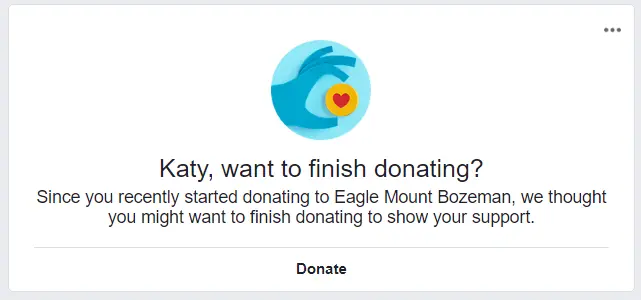
Google Donate Button
If you’ve been wondering how to quickly get donations from search traffic, Google recently rolled out their donate button option for nonprofits.
- Who You Can Reach: The Google donate button will potentially show up in search results related to the name of your organization. Anyone looking for your nonprofit using Google could see it, and they don’t need a Google account to make a gift.
- How to Get Donations: You must first be a member of Google for Nonprofits with a 501(c)(3) status in the United States.
- Processing & Fees: Donations are collected and distributed through the Network for Good donor advised fund. You will need to be listed in the Guidestar database to receive your donations, and your Guidestar account must be set to opt-in to donations. (Both of these things should happen automatically when your nonprofit registers with the IRS.) For donors in the US, their entire contribution goes to the nonprofit. Read more information for donors.
- Payout: You must collect at least $11 to get a payout, which happens on a monthly basis. Be prepared to wait up to 2 months to get the funds.
- Donor Data: You will not receive any contact information for donors, although this may change in the future. Donors receive an automated receipt from Network for Good. See related FAQs.
- What It Looks Like: Here is an example of how the button appears for Goodwill and what happens when someone clicks through the Google donation process.
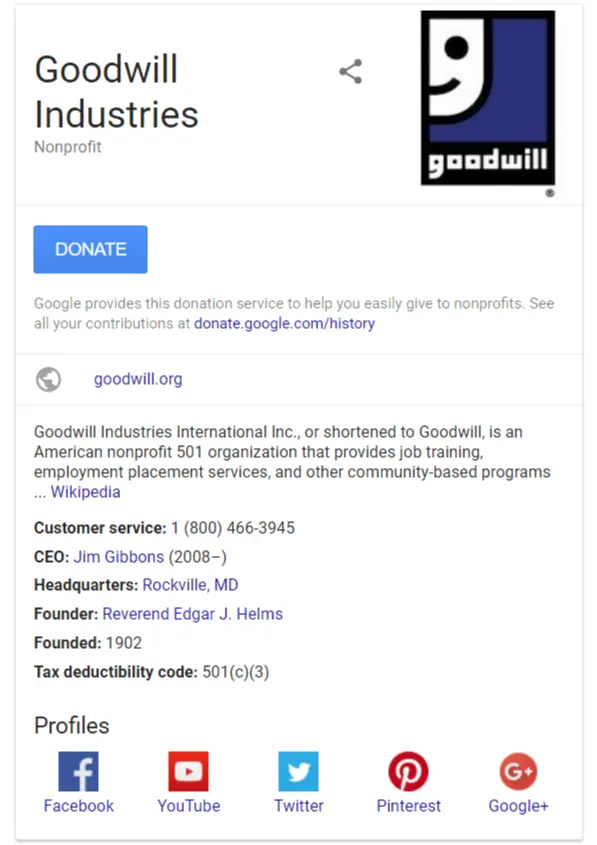
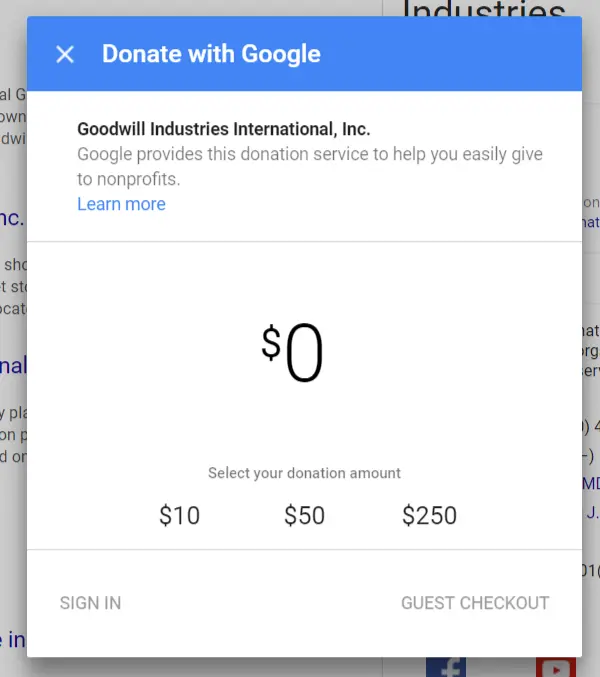
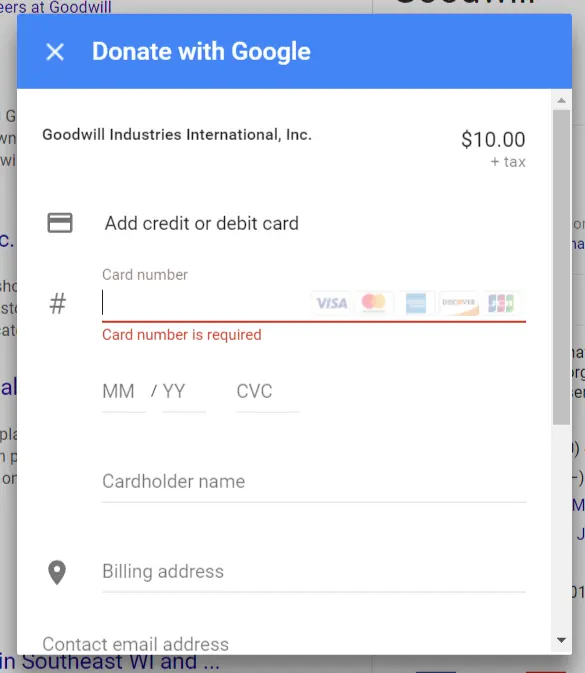
YouTube Donation Card
Does your nonprofit have a compelling video that might convince someone to give? Raise money on YouTube using donation cards, which is like adding a donate button on top of the videos that you upload and manage in your channel.
- Who You Can Reach: Anyone viewing your videos can use the YouTube donation option, from people finding you for the first time or your loyal supporters and subscribers. Videos with strong calls-to-action will likely have better results using this feature.
- How to Get Donations: You must have a Google for Nonprofits account and a YouTube channel before getting started. From there, enroll in the YouTube for Nonprofits Program and then start adding donation cards to videos of your choosing. As an added bonus, use the YouTube Analytics Cards report to see how the cards perform over time.
- Processing & Fees: Google doesn’t charge fees and also covers the processing fees for Network for Good, which collects and distributes donations. Just like the Google donate button, your nonprofit will need to be listed by Guidestar and your Guidestar account must be set to opt-in to donations.
- Payout: You must collect at least $10 to get a payout, which happens on a monthly basis. Be prepared to wait up to 2 months to get the funds.
- Donor Data: You will not receive any contact information for donors, although this may change in the future. Donors receive an automated receipt from Network for Good.
- What It Looks Like: In this example from Big Brothers Big Sisters, you can see how the card appears on the video and what happens when someone clicks on it.
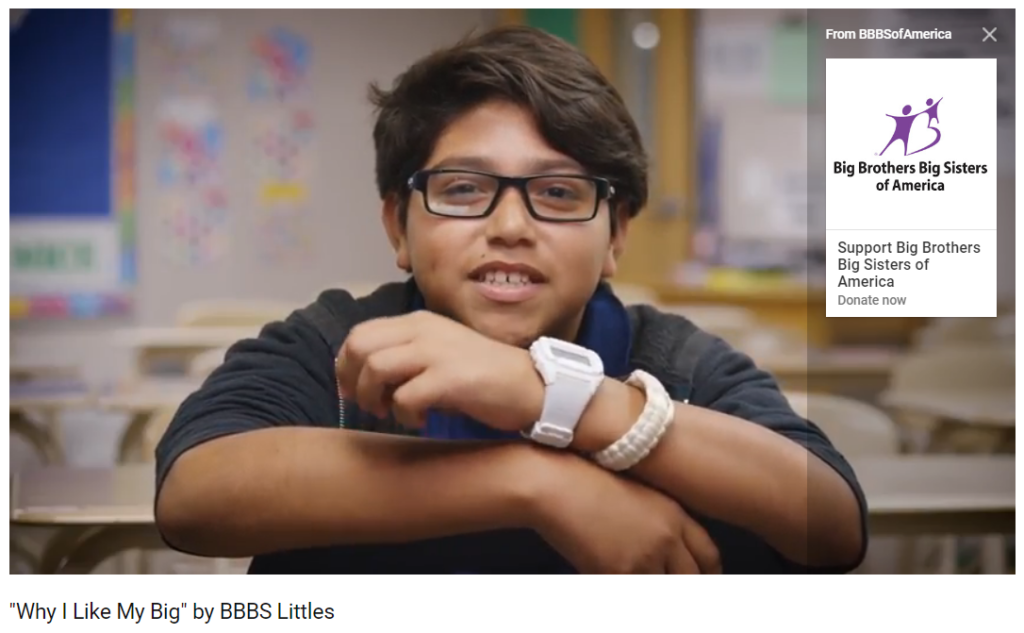
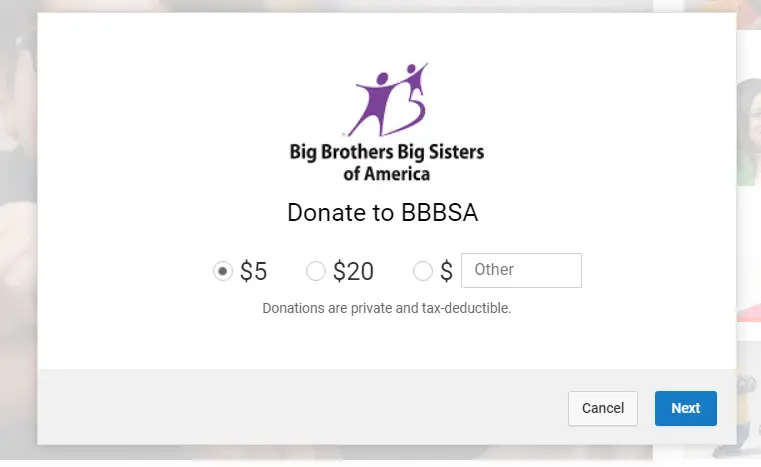
Guidestar Donate Button
If you haven’t paid much attention to your nonprofit’s profile on the Guidestar website, the ability to add a donate button might be a good reason to give it a makeover. For organizations that use the Guidestar seal on their website to link back to their profile, adding this donate button could continue to motivate your traffic to give even once they leave your site for Guidestar.
- Who You Can Reach: Unlike the other options in this list, the Guidestar donate button is more targeted to a savvy potential donor who is doing their due diligence about your organization. Someone researching your nonprofit may land on your Guidestar profile to learn more about your financials and credibility, which is a good opportunity to get them to give if you have a compelling case.
- How to Get Donations: As with the Google and YouTube donate buttons, you’ll need to have a Guidestar profile. To get the button, log in to Guidestar, opt-in to third party payments, and update your profile options to give Guidestar permission to add it. You’ll need to have a Bronze Seal of Transparency or higher.
- Processing & Fees: It’s free to have the button, but donations are processed and dispersed by Network For Good, which receives 4.75% of each transaction.
- Payout: You can choose to receive funds via direct deposit when you setup a Network For Good DonateLite account. Otherwise, you’ll need to wait for a check with an unknown timeline.
- Donor Data: You can export a donor report from your nonprofit profile in Guidestar, which includes the donor name, address, date, amount and email address. Donors can choose to be anonymous.
- What It Looks Like: Here’s an example from the Make-a-Wish Guidestar profile, including what the form looks like when someone clicks the button.
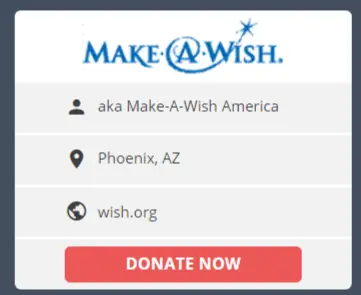
*New* GoFundMe Charity Donate Button
In late 2019, GoFundMe launched their new Charity platform for nonprofits. Unlike the donate button options listed above, GoFundMe Charity actually offers a donate button that can be included directly on your nonprofit’s website to accept one-time or recurring gifts. It doesn’t have to be linked to a specific campaign, meaning that people who click it will go to an offsite GoFundMe-hosted donation form that can be branded for your organization.
- Who You Can Reach: Because this button can be added directly to your website, you can potentially any visitor to your site.
- How to Get Donations: You’ll need to sign up for GoFundMe charity. From there, the button can be added to your website using a WordPress Plugin or the Charity Button Editor.
- Processing & Fees: Using the button doesn’t come with a platform or subscription fee, but you will have a 1.9% +$0.30 processing fee on each donation.
- Payout: Based on our conversation with GoFundMe CEO Rob Solomon, the distribution of funds varies based on the payment processor you use, ranging from daily to monthly.
- Donor Data: Good news! In the platform’s Report Center, you can access information about your donors, including contact information, for folks who’ve donated using the button. You can also set up integrations with CRMs and marketing services like Salesforce and Mailchimp to feed that information directly to other tools.
- What It Looks Like: Here’s an example from Going Places that shows the donate button at the top of their homepage and then the GoFundMe-hosted donation form.
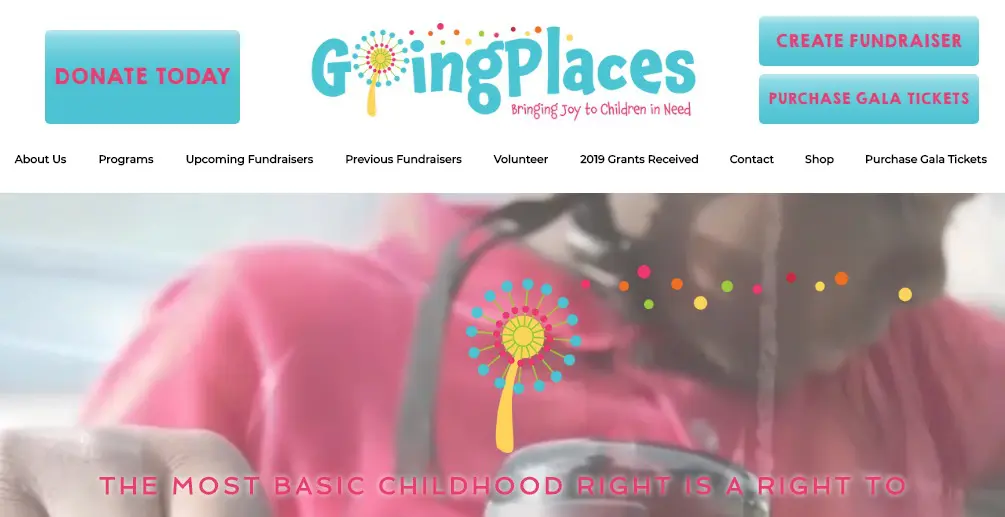
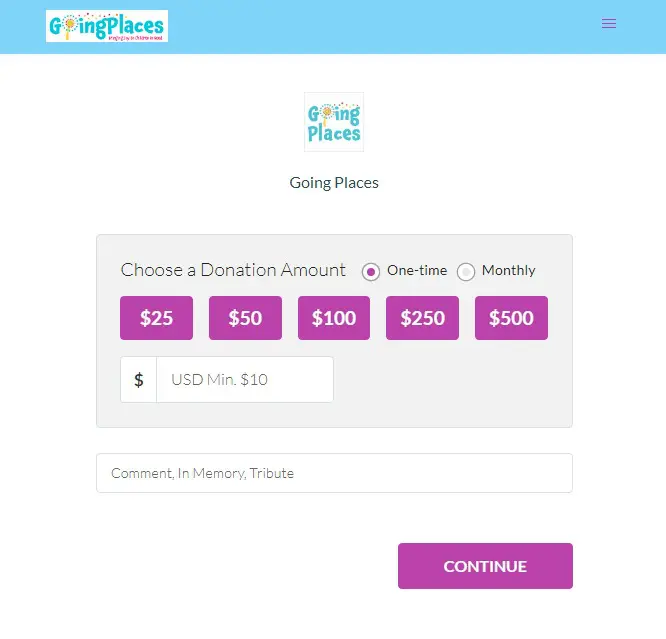
Which Buttons Are Right For You?
In terms of getting set up, each of these options has a similar process and most rely on Network for Good. It may be tempting to use them all, but you’ll likely only see results from the websites where you put in effort with your content and engagement strategy.
As with any fundraising tactic, don’t forget to take the long view, weighing the benefits of quick win donations versus the ability to retain donors in the future. As of now, the Google and YouTube donate buttons make it nearly impossible to reach donors unless they are the ones to tell you about a gift. Until that changes, these options are geared more toward one-time donors that don’t have a lot of expectations when it comes to follow-up.
You’re not alone in looking for ways to fundraise online that don’t take a lot of effort or don’t cost more money than they’re worth. Luckily, offsite (and new onsite) donate button options are making it increasingly easy and affordable to ask for gifts in the moment – and in the places where your potential supporters are already going.
What’s been your experience using any of these donation button options? Are there any others that you recommend? Let’s share in the comments.

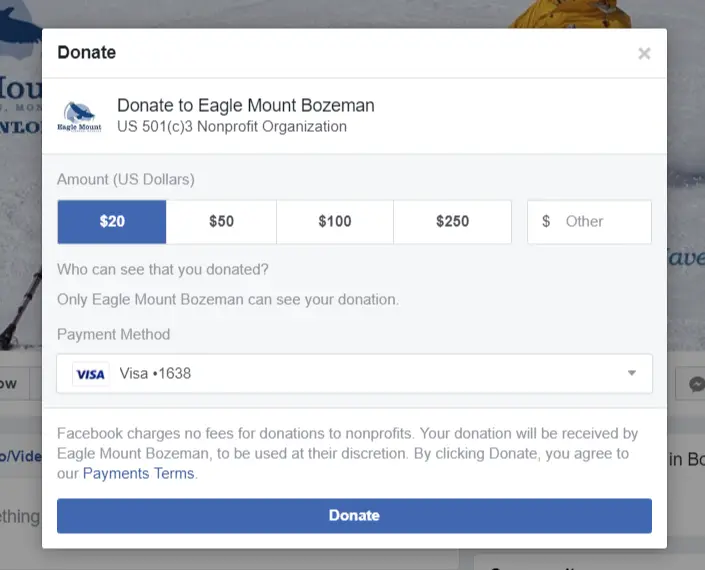
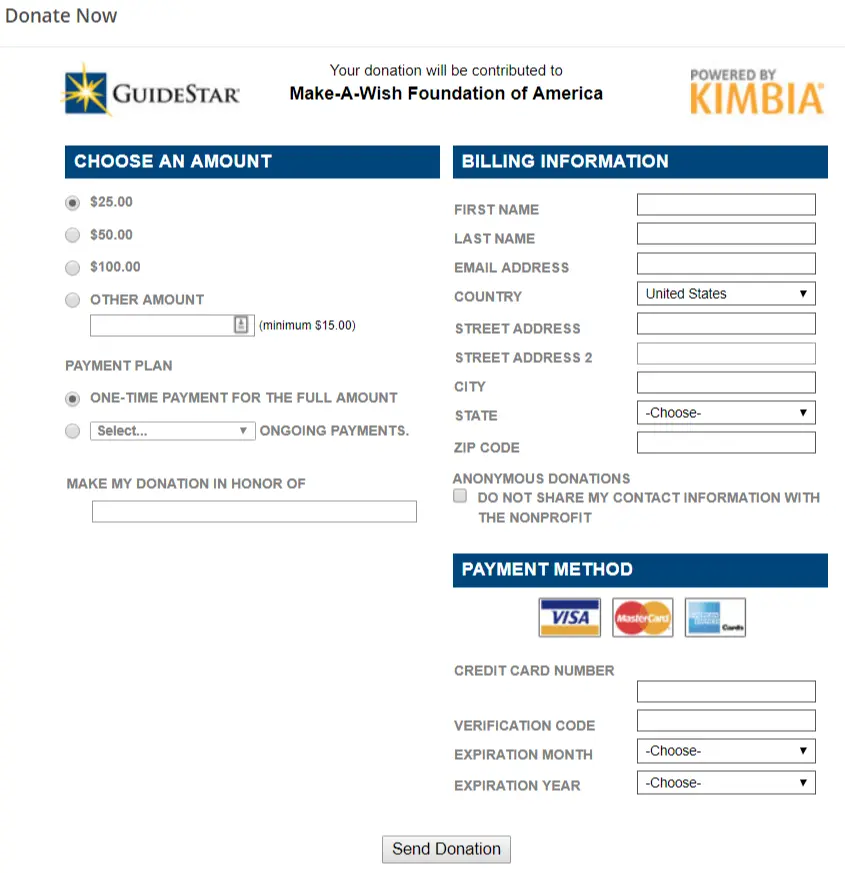
This is something interesting, we have to charity if God gives us that much money.
We need to help those who are in need.
I am touched by this blog.
Thank You
Thanks for commenting, Martin. I’m glad you’re enjoying the blog!
Nice article. I shall try at the future time.
Glad you enjoyed the post! Best wishes on your online fundraising efforts.
Good article, but how do you thank people on Facebook if they have used the Donate button?
Hi Dawn – In the donor data report (specifically the Daily Transaction Report), you can see the email addresses of people who have donated if they opted in to share that with your organization. If you are set up to receive donations through Network for Good or PayPal, please refer to this chart from Facebook about the types of reports available. If a donor has provided you with contact information, you can use that to thank them directly. Otherwise, they will get an automated receipt from Facebook for their records.
I hope that helps!
Do you know if there is a way to add a donate button to Facebook posts that are already published? I can’t find an option for it other than when you are first setting up the post to be published.
Hi Ali – Facebook only talks about this option, which is geared more toward an individual rather than an organization’s own page.
I think the process on mobile is easier. When you edit a post, at the very bottom of your list of options you should see “Support Nonprofit,” which is where you can select your organization and then see the donate button. Let me know if that works for you!
Thanks for this great information and the incredible work you are doing to help build nonprofits around the world. Is it possible that you could soon widen your reach to benefit countries in Africa, like Uganda as well? We would really benefit from your service.
Hello Denis – Thanks for your kind comment! We do work with clients in other countries and would love to hear from you if you want to learn more about our services. You can contact us anytime.